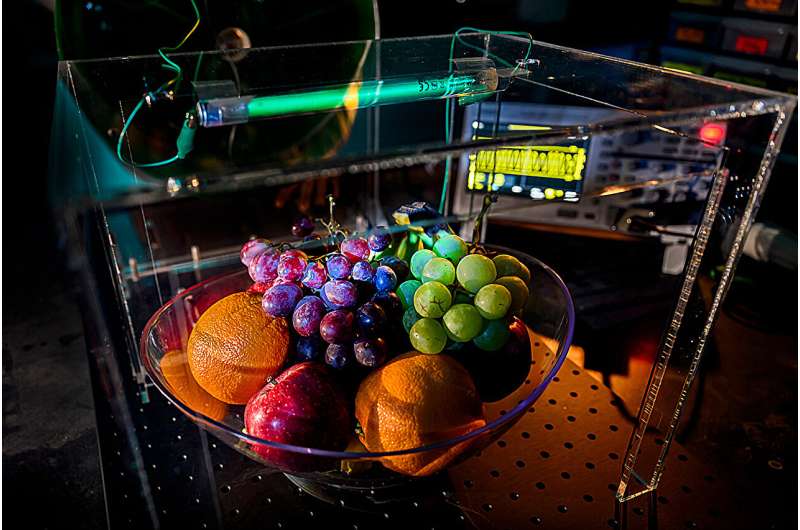Lightning sparks scientists’ design of ultraviolet-C device for food sanitization

Scientists at the University of Illinois Urbana-Champaign have developed a portable, self-powered ultraviolet-C device called the Tribo-sanitizer that can inactivate two of the bacteria responsible for many foodborne illnesses and deaths.
The Tribo-sanitizer’s UVC lamp is powered using the triboelectric effect—electricity that is generated when two dissimilar materials come into contact. In tests, the Tribo-sanitizer successfully inactivated two potentially deadly foodborne bacteria, Escherichia coli O157:H7, and Listeria monocytogenes, mainly by damaging their DNA, according to findings published in the journal Nano Energy.
The bacteria selected as testing targets are two of the most common causes of serious foodborne illness outbreaks in the U.S. Escherichia coli produces toxins that can cause severe abdominal cramps, fever, bloody diarrhea, and kidney failure, and Listeria monocytogenes can cause listeriosis, which has the highest rates of hospitalization and mortality of any foodborne illness.
The team assessed the Tribo-sanitizer’s decontamination capability with bacteria in liquids and on three solids—fresh apple peels, romaine lettuce, and polyethylene terephthalate, commonly known as PET, a popular material for food and beverage packaging.
The results indicated that the Tribo-sanitizer had strong potential to meet the Food and Drug Administration’s sanitization standards. Specifically, the device “achieved reductions of at least 99.999% on the E. coli strain in buffer solution and on PET, demonstrating the Tribo-sanitizer’s excellent decontamination ability,” said corresponding author Yi-Cheng Wang, a professor of food safety and engineering.
On produce, the device achieved smaller but still useful reductions of about 99.98% for the E. coli bacteria 99.9% for L. monocytogenes on the apple peels, and 99.8% for E. coli and 98% for L. monocytogenes on romaine lettuce, according to the paper.
These outcomes “are comparable to those reported in other studies that utilized UV light with a commercial power source for the decontamination of fresh produce,” said doctoral student Zachary (Zhenhui) Jin, who was the co-first author of the paper with alumnus Fujunzhu Zhao. Graduate student Longwen Li also participated in the study.
The Tribo-sanitizer’s triboelectric power source can convert mechanical energy from the ambient environment—for instance, from human motions and wind—that would otherwise be wasted, which is why the research team describes it as “self-powered,” Wang said.
An air gap that the team incorporated into the design of their triboelectric power source mimics lightning by electrostatically breaking down air. This innovation increased Tribo-sanitizer’s output to more than 4,000 volts and markedly increased the brightness of its UVC lamp, according to the study.
While light-based technologies like Tribo-sanitizer’s lamp “can be very effective when surfaces are directly exposed to the light source,” Wang said they may not adequately decontaminate areas that are not directly illuminated, such as uneven or rough surfaces on lettuces and apple peels.
“This could be addressed by incorporating other decontamination methods or using multiple light sources at different angles,” he said. “That is one of the future directions we are working on. And if properly incorporated into existing facilities such as transportation or storage units, the Tribo-sanitizer could potentially provide continuous decontamination throughout the supply chain without the need for commercial power.”
Although the length of time needed to achieve a 99.999% reduction in E. coli bacteria was long—currently 90 minutes—Jin said that the device’s potential to achieve continuous decontamination, such as within trucks on the highway, means that this extended time should not be seen as a major drawback. The team is continuing its efforts to improve the Tribo-sanitizer, and “this time can be expected to be much shorter in the future,” he said.
According to the World Health Organization, foodborne illness affects almost 600 million people annually, resulting in 420,000 deaths. The economic cost of dealing with the consequences of food contamination is more than $15.6 billion per year in the U.S. and $110 billion in low- and middle-income countries, according to estimates by the U.S. Department of Agriculture and the WHO, respectively. Wang said that the Tribo-sanitizer represents a novel means of alleviating these problems.
Consumers could use Tribo-sanitizers at home to sanitize surfaces, foods, and more because “the estimated cost of the materials used to build the device is less than $70,” Jin said.
The device’s self-powered character also gives it “excellent potential for use in low-resource settings such as natural disaster areas and conflict zones where electricity is absent or unreliable,” Li said.
More information:
Zhenhui Jin et al, Tribo-sanitizer: A portable and self-powered UV device for enhancing food safety, Nano Energy (2023). DOI: 10.1016/j.nanoen.2023.108675
Citation:
Lightning sparks scientists’ design of ultraviolet-C device for food sanitization (2023, December 5)
retrieved 5 December 2023
from https://techxplore.com/news/2023-12-lightning-scientists-ultraviolet-c-device-food.html
This document is subject to copyright. Apart from any fair dealing for the purpose of private study or research, no
part may be reproduced without the written permission. The content is provided for information purposes only.
For all the latest Technology News Click Here
For the latest news and updates, follow us on Google News.

